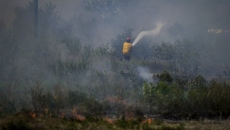The number of active wildfires in British Columbia has dipped below 450 as cooler weather and recent rain has cut the fire risk, although another hot spell could wipe out those gains as large sections of the province wilt under severe drought.
The BC Wildfire Service website shows only small pockets of extreme wildfire risk, mainly in southeastern B.C., where almost no rain fell earlier this week.
In the days and weeks ahead, we will continue to grow our capacity by adding additional contract resources where necessary.
— BC Wildfire Service (@BCGovFireInfo) July 26, 2023
We offer our deepest gratitude to the efforts of all involved in this team, and we are extremely proud to stand beside you. Thank you!
Three of B.C.'s 23 wildfires of note, which are blazes that are highly visible or potentially damaging, are located in southeastern B.C., including the suspected lightning-caused fire that broke out Monday west of Invermere.
It has now charred just under 10 square kilometres of mountainous terrain, forcing evacuations and alerts covering a ski resort and more than 1,000 properties, but the wildfire service says winds that fanned the flames Tuesday are expected to ease.
Tuesday's strong winds in the southeast also forced evacuation orders for a handful of properties, including the Nipika Mountain Resort, as an almost three-week-old, nearly 11-square kilometre wildfire flared just east of Invermere.
Structure protection specialists have been assigned to that area while a heavy equipment crew is working to build guards around the properties.
The Ministry of Emergency Management and Climate Readiness says more than 1,000 people are under evacuation order across B.C., while more than 4,000 more have been warned to be ready to leave on very short notice.
Of the 1,484 fires recorded in B.C., since the start of this fire season, the wildfire service says just over 1,000 have been caused by lightning, human activity is linked to 367 others and the cause of 97 is undetermined.
Almost 15,000 square kilometres of trees, bush and grassland has been lost to wildfires since April 1, 2023, breaking the record set in 2018.






